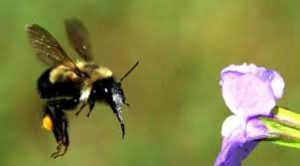28
Nov
Study Finds Pesticides Take the Buzz Out of Bumblebees
 (Beyond Pesticides, November 28, 2017) Bumblebees exposed to field-realistic levels of neonicotinoid insecticides have problems with “buzz pollination” that results in reduced pollen collection, according to new research published in Scientific Reports. This is the latest science to tease out the complex ways in which neonicotinoids interfere with these important pollinators, providing yet another reason to eliminate these highly toxic, systemic insecticides from the environment.
(Beyond Pesticides, November 28, 2017) Bumblebees exposed to field-realistic levels of neonicotinoid insecticides have problems with “buzz pollination” that results in reduced pollen collection, according to new research published in Scientific Reports. This is the latest science to tease out the complex ways in which neonicotinoids interfere with these important pollinators, providing yet another reason to eliminate these highly toxic, systemic insecticides from the environment.
Flowers that bumblebees pollinate require the insects to emit soundwaves, or ‘sonicate’ to release their pollen, and bumblebees must perfect their techniques over time in order to maximize the pollen they are able to collect. Researchers tested the effect of neonicotinoids on bumblebees’ sonication abilities by exposing them to field realistic doses of the insecticide thiamethoxam at rates of 2 parts per billion (ppb) and 10 ppb, and observing their ability to successfully collect pollen. A control group that never came in contact with thiamethoxam was also used to compare the progress of the exposed group.
Lead author of the study, Penelope Whitehorn, PhD, indicated, “We found that control bees, who were not exposed to the pesticide, improved their pollen collection as they gained experience, which we interpreted as an ability to learn to buzz pollinate better.”
Dr. Whitehorn continued, “However, bees that came into contact with pesticide did not collect more pollen as they gained more experience, and by the end of the experiment collected between 47 percent [in the 2 ppb group] and 56 percent less pollen [in the 10 ppb group] compared to the control bees.”
Bumblebees exposed to the insecticide had a buzz that was shorter than control bees, and they displayed less effort in their attempts to sonicate. “Our result is the first to demonstrate quantitative changes in the type of buzzes produced by bees exposed to field-realistic levels of neonicotinoid,” Dr. Whitehorn said.
While this research is the first to quantify changes in buzzing, it is not the first to show these notorious chemicals inhibit bumblebees’ pollination skills. Research in early 2017 found that realistic exposure to the neonicotinoid imidacloprid resulted in worker bees spending less time caring for young and pollinating flowers. This research is consistent with other studies that link neonicotinoid use to reduced learning in bees, as well as other impacts, such as those on colony size, and reproductive success.
When this study was presented preliminarily at the British Ecological Society’s annual meeting in 2016, the chemical company Syngenta, a major manufacturer of neonicotinoids (along with Bayer), argued that exposure to thiamethoxam in the field was usually closer to 3 ppb than 10 ppb, as researchers had only observed the impacts of 10 ppb exposure. Researchers took that suggestion, and indeed found similar effects at an even lower level of 2 ppb, which, as Dr. Whitehorn noted, decreased pollination collection by 47% compared to unexposed bees.
Again and again, the pesticide industry attempts to dismiss and criticize independent science that shows the harm of its products, as its profits and CEO salaries soar. As evidence mounts that the Trump Administration is working closely with chemical companies, the best way to increase the pressure is to get active in your local community. Work to pass pesticide policies that protect both honey bees and wild pollinators, as numerous communities (see yellow boxes) have done. For assistance, contact Beyond Pesticides at [email protected].
All unattributed positions and opinions in this piece are those of Beyond Pesticides.
Source: University of Stirling Press Release










